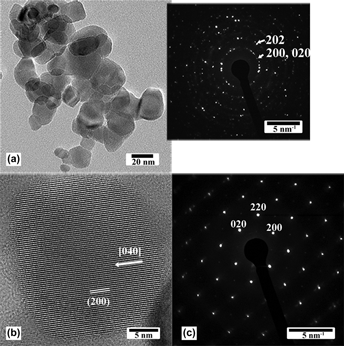Crossref Citations
This article has been cited by the following publications. This list is generated based on data provided by
Crossref.
Shen, Zhenguang
Zhao, Zengying
Qian, Jingwen
Peng, Zhijian
and
Fu, Xiuli
2016.
Synthesis of WO3−x nanomaterials with controlled morphology and composition for highly efficient photocatalysis.
Journal of Materials Research,
Vol. 31,
Issue. 8,
p.
1065.
BARROSO‐BOGEAT, A.
ALEXANDRE‐FRANCO, M.
FERNÁNDEZ‐GONZÁLEZ, C.
and
GÓMEZ‐SERRANO, V.
2016.
Particle size distribution and morphological changes in activated carbon‐metal oxide hybrid catalysts prepared under different heating conditions.
Journal of Microscopy,
Vol. 261,
Issue. 3,
p.
227.
Wang, Zishuai
Hu, Ming
Wei, Yulong
Liu, Junfeng
and
Qin, Yuxiang
2016.
Low-temperature NO2-sensing properties and morphology-controllable solvothermal synthesis of tungsten oxide nanosheets/nanorods.
Applied Surface Science,
Vol. 362,
Issue. ,
p.
525.
Khan, Ibrahim
Abdalla, Akram
and
Qurashi, Ahsanulhaq
2017.
Synthesis of hierarchical WO3 and Bi2O3/WO3 nanocomposite for solar-driven water splitting applications.
International Journal of Hydrogen Energy,
Vol. 42,
Issue. 5,
p.
3431.
Nagarjuna, Ravikiran
Challagulla, Swapna
Sahu, Pooja
Roy, Sounak
and
Ganesan, Ramakrishnan
2017.
Polymerizable sol–gel synthesis of nano-crystalline WO 3 and its photocatalytic Cr(VI) reduction under visible light.
Advanced Powder Technology,
Vol. 28,
Issue. 12,
p.
3265.
Olya, Mohammad Ebrahim
Montazerghaem, Leila
and
Naeimi, Alireza
2017.
Synthesis, characterization and applications of WO3:Eu as a new photocatalyst for dye removal of colored wastewater.
Desalination and Water Treatment,
Vol. 67,
Issue. ,
p.
318.
Altanany, Sameh M.
Gondal, M. A.
and
Baig, Umair
2018.
Synthesis and characterization of CuO/WO3 nanocomposite using hybrid method: Simple precipitation and pulsed laser ablation in liquids technique.
Vol. 1976,
Issue. ,
p.
020014.
Boga, Biborka
Székely, István
Pap, Zsolt
Baia, Lucian
and
Baia, Monica
2018.
Detailed Spectroscopic and Structural Analysis of TiO2/WO3 Composite Semiconductors.
Journal of Spectroscopy,
Vol. 2018,
Issue. ,
p.
1.
Tsuyumoto, Isao
2018.
Facile synthesis of nanocrystalline hexagonal tungsten trioxide from metallic tungsten powder and hydrogen peroxide.
Journal of the American Ceramic Society,
Vol. 101,
Issue. 2,
p.
509.
Lopes, L.F.
Pontes, F.M.
Garcia, L.O.
Pontes, D.S.L.
Padovani, D.
Chiquito, A.J.
Teixeira, S.R.
Colmenares, Y.N.
Mastelaro, V.R.
and
Longo, E.
2018.
Silver-controlled evolution of morphological, structural, and optical properties of three-dimensional hierarchical WO 3 structures synthesized from hydrothermal method.
Journal of Alloys and Compounds,
Vol. 736,
Issue. ,
p.
143.
Jamshidi, Parastoo
and
Shemirani, Farzaneh
2018.
Synthesis of a magnetic WO3 nanocomposite for use in highly selective preconcentration of Pb(II) prior to its quantification by FAAS.
Microchimica Acta,
Vol. 185,
Issue. 9,
Evecan, Dilek
Kaplan, Ş. Samet
Sönmez, M. Şeref
Yıldırım, Saffettin
Okutan, Merve
Deligöz, Hüseyin
and
Zayim, Esra
2019.
Smart glass electrochromic device fabrication of uniform tungsten oxide films from its powder synthesized by solution combustion method.
Microelectronic Engineering,
Vol. 215,
Issue. ,
p.
110989.
Figen, Halit Eren
2019.
Hegzagonal WO3 nano parçacılarının PEG Destekli Hidrotermal Sentezi.
European Journal of Science and Technology,
p.
969.
Ying, Y.L.
Pung, S.Y.
Sreekantan, S.
Yee, Y.F.
Ong, M.T.
and
Pung, Y.F.
2019.
Structural and Antibacterial Properties of WO3/ZnO Hybrid Particles against Pathogenic Bacteria.
Materials Today: Proceedings,
Vol. 17,
Issue. ,
p.
1008.
Zahoor, Muhammad Tahir
Ahmad, Mashkoor
Maaz, Khan
Karim, Shafqat
Waheed, Khalid
Ali, Ghafar
Hussain, Shafqat
Hussain, Syed Zahid
and
Nisar, Amjad
2019.
Tungsten oxide multifunctional nanostructures: Enhanced environmental and sensing applications.
Materials Chemistry and Physics,
Vol. 221,
Issue. ,
p.
250.
Hui, Fei
Chen, Yanhui
Zhou, Quan
Wang, Chunhui
Qi, Meng
Li, Wei
Yang, Luyan
and
Li, Ang
2019.
Preparation and Gas Sensitivity of Two-Dimensional Tungsten Oxide Supported High Density Gold Nanoparticles.
IOP Conference Series: Materials Science and Engineering,
Vol. 562,
Issue. 1,
p.
012091.
Liu, Cong
Shen, Kai
Lin, Dongxu
Cao, Ye
Qiu, Shudi
Zheng, Jianzha
Bao, Feixiong
Gao, Yanyan
Zhu, Hongbing
Li, Zhiqiang
and
Mai, Yaohua
2020.
Back Contact Interfacial Modification in Highly-Efficient All-Inorganic Planar n-i-p Sb2Se3 Solar Cells.
ACS Applied Materials & Interfaces,
Vol. 12,
Issue. 34,
p.
38397.
Madheslu, Manikandan
Sadasivam, Narendhran
Ameerbasha, Simin Sabana
and
Ramakrishnan, Vishnu
2020.
Cellular and Molecular Phytotoxicity of Heavy Metals.
p.
403.
Mohammed, Haleemah J.
Ali, Nathera A.
Jwad, Basheer H.
and
Ali, Mutaur R
2020.
Advanced nano membrane for an alkaline Fuel Cell.
Journal of Physics: Conference Series,
Vol. 1660,
Issue. 1,
p.
012046.
Aliasghari, H.
Arabi, A.M.
and
Haratizadeh, H.
2020.
A novel approach for solution combustion synthesis of tungsten oxide nanoparticles for photocatalytic and electrochromic applications.
Ceramics International,
Vol. 46,
Issue. 1,
p.
403.
